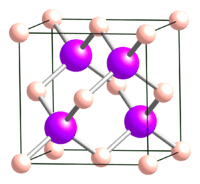Boron arsenide
 BAs | |
 B12As2 | |
| Identifiers | |
|---|---|
| 12005-69-5 | |
| Properties | |
| BAs or B12As2 | |
| Molar mass | 85.733 g/mol |
| Density | 5.22 g/cm3, solid |
| Melting point | 2,027 °C (3,681 °F; 2,300 K) |
| Insoluble | |
| Band gap | 1.50 eV(BAs); 3.47 eV(B12As2) |
| Hazards | |
| EU classification (DSD) |
N/A |
| Related compounds | |
| Other anions |
Boron nitride Boron phosphide Boron antimonide |
| Other cations |
Aluminium arsenide Gallium arsenide Indium arsenide |
| Except where otherwise noted, data are given for materials in their standard state (at 25 °C [77 °F], 100 kPa). | |
| | |
| Infobox references | |
Boron arsenide is the chemical compound BAs. Other boron arsenide compounds are known, including the subarsenide B12As2[1]
Properties
It is a cubic (sphalerite) semiconductor in the III-V family with a lattice constant of 0.4777 nm and an indirect bandgap of roughly 1.5 eV.[2] It can be alloyed with gallium arsenide to produce ternary and quaternary semiconductors.[3] Cubic BAs is reported to decompose to the subarsenide B12As2 at temperatures above 920 °C.[4]
Boron subarsenide
Boron arsenide also occurs as subarsenides, including icosahedral boride, B12As2.[1] It belongs to R-3m space group with a rhombohedral structure based on clusters of boron atoms and two-atom As-As chains. It is a wide-bandgap semiconductor (3.47 eV) with the extraordinary ability to “self-heal” radiation damage.[5] This form can be grown on substrates such as silicon carbide.[6]
Applications
Boron arsenide has been proposed as a material for solar cell fabrication,[3][7] although it is not currently used for this purpose.
The subarsenide B12As2 may be an attractive choice for devices exposed to radiation which degrades the electrical properties of conventional semiconductors, such as betavoltaic cells, which electrical energy by coupling a radioactive beta emitter to a semiconductor junction, and other space electronics.
A team at the Naval Research Laboratory and Boston College found the calculated thermal conductivity of cubic boron arsenide, BAs, is remarkably high. At room temperature, it is expected to exhibit heat conductivity, κ, of over 2000 W/(m·K), which is comparable to diamond and graphite, and may exceed that of diamond at higher temperatures, according to researchers L. Lindsay, D.A. Broido and T.L. Reinecke.[8][9]
References
- 1 2 "Semiconductor Research". University Bristol, Applied Spectroscopy Group.
- ↑ Hart, G. L. W.; Zunger, A. (2000). "Electronic Structure of BAs and Boride III-V Alloys". Physical Review B 62 (20): 13522–13537. arXiv:cond-mat/0009063. doi:10.1103/PhysRevB.62.13522.
- 1 2 J. F. Geisz, D. J. Friedman, J. M. Olson, S. R. Kurtz, R. C. Reedy, A. B. Swartzlander, B. M. Keyes, and A. G. Norman, "BGaInAs alloys lattice matched to GaAs," Applied Phys. Lett. 76, No. 11, 13 Mar. 2000.
- ↑ T. L. Chu and A. E. Hyslop, J. Electrochem. Soc., Vol. 121, 412 (1974).
- ↑ M. Carrard, D. Emin, and L. Zuppiroli, Phys. Rev. B, Vol. 51, 11270 (1995).
- ↑ Chen, H.; Wang, G.; Dudley, M.; Xu, Z.; Edgar, J. H.; Batten, T.; Kuball, M.; Zhang, L.; Zhu, Y. (2008). "Single-Crystalline B12As2 on m-plane (1-100)15R-SiC". Applied Physics Letters 92 (23): 231917. doi:10.1063/1.2945635.
- ↑ Boone, J. L. and Vandoren, T. P., Boron arsenide thin film solar cell development, Final Report, Eagle-Picher Industries, Inc., Miami, OK. abstract (retrieved May 15, 2014)
- ↑ Phys.org news, An unlikely competitor for diamond as the best thermal conductor, Jul 08, 2013 (retrieved May 15, 2014)
- ↑ First-principles determination of ultrahigh thermal conductivity of boron arsenide: A competitor for diamond?
- King, R. B. (1999). Boron Chemistry at the Millennium. New York: Elsevier. ISBN 0-444-72006-5.
- Ownby, P. D. (1975). "Ordered Boron Arsenide". Journal of the American Ceramic Society 58 (7–8): 359–360. doi:10.1111/j.1151-2916.1975.tb11514.x.
External links
- Fiz Chemie Berlin thermophysical database entry
- Matweb data
- Phys.org news on Thermal Conductivity
| ||||||